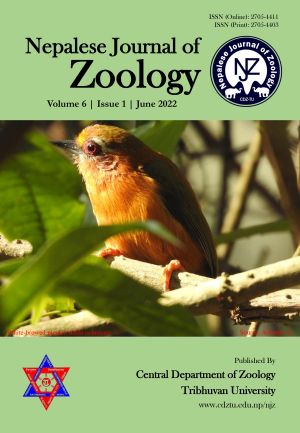Histopathology of the fish infected with the epizootic ulcerative syndrome in Eastern Nepal
DOI:
https://doi.org/10.3126/njz.v6i1.46750Keywords:
Aseptate fungus, Fish samples, Granuloma, Hemorrhage, ZoosporesAbstract
Epizootic ulcerative syndrome (EUS) is the major disease of fish which causes high mortality of fish in eastern Nepal since its initial outbreak. Of the 445 EUS infected fish samples, the suspected fungus was identified in eight spp. during the five years study period following standard methods to isolate, culture and identification. The sections of muscles, livers, and kidneys of infected fish samples showed the outbreak of EUS due to the presence of Aphanomyces spp. A complete loss of epidermis and the underlying musculature was replaced by granulomatous and inflammatory tissues. In some areas, myonecrosis and fungal hyphae, black stained with GMS, reflected a positivity for the presence of fungus. Pathogenicity test in Heteropneustes fossilis showed some lesions and 43.33% mortality when isolated zoospores were injected into experimental fish samples.
Downloads
Downloads
Published
How to Cite
Issue
Section
License

This work is licensed under a Creative Commons Attribution-NonCommercial 4.0 International License.
This license enables reusers to distribute, remix, adapt, and build upon the material in any medium or format for noncommercial purposes only, and only so long as attribution is given to the creator.

